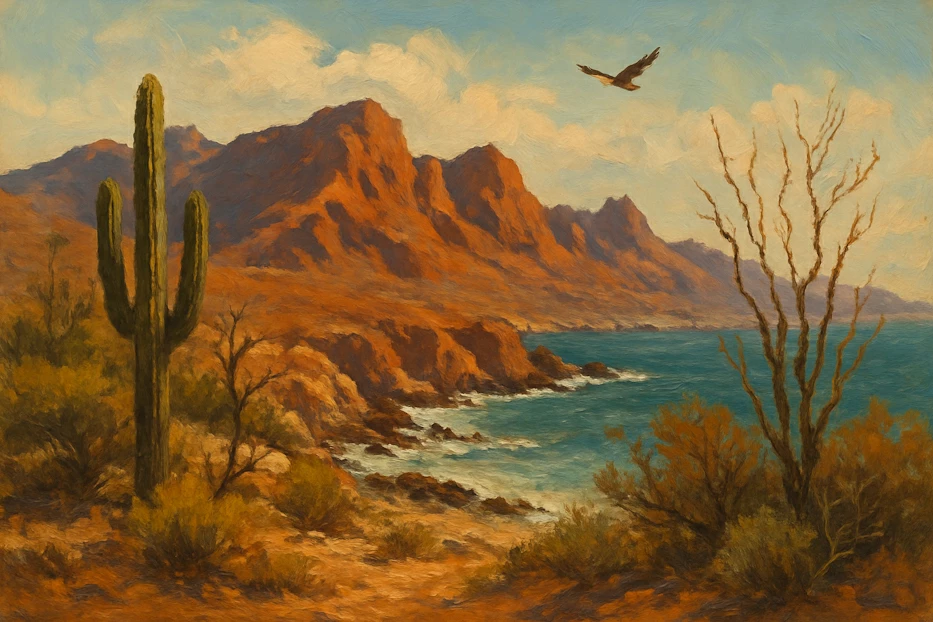As a protected nature reserve, Isla Tiburón offers a rare glimpse into an ecosystem largely untouched by human interference.
Isla Tiburón, meaning ‘Shark Island,’ is Mexico’s largest island. It is a fascinating, largely untouched natural area rich with wildlife, dramatic mountains, and a cultural legacy sacred to the Seri people.
Table of Contents
Geography of Isla Tiburón
Isla Tiburón lies just off the coast of Sonora in the sparkling blue waters of the Gulf of California—also known as the Sea of Cortez—and covers an area of 1,201 square kilometers (464 square miles).
This gulf is famous for its incredible biodiversity, drawing marine life ranging from sea turtles to majestic whales.
A Comparison of 5 North American Islands
To understand Isla Tiburón’s scale, here’s how it compares to other major islands in North America:
| Island | Location | Area (sq. km) | Area (sq. mi) | Country |
|---|---|---|---|---|
| Baffin Island | Arctic | 507,451 | 195,928 | Canada |
| Cuba | Caribbean | 110,860 | 42,800 | Cuba |
| Greenland | Arctic | 2,166,086 | 836,330 | Denmark (Autonomous) |
| Isla Tiburón | North Pacific | 1,201 | 464 | Mexico |
| Long Island | North Atlantic | 3,564 | 1,376 | United States |
In 1963, the Mexican government officially designated Isla Tiburón a protected nature reserve, limiting human activity to keep the island as natural as possible.
This protection means that visitors to the largest island in Mexico get to see a slice of nature that remains largely untouched, an experience that’s increasingly rare in today’s world.
Direct Ferries
Routes, Schedules, Prices
Ferries to Mexico
Unique Geographical Features of Mexico’s Largest Island
Isla Tiburón is a vast, protected desert island with an array of rugged landscapes. The island’s terrain is dominated by two parallel mountain ranges that run north to south: the Sierra Kunkaak and the Sierra Menor.
These volcanic ranges are separated by the broad Agua Dulce Valley, a feature that adds to the diversity of the island’s topography. The peaks of the Sierra Kunkaak and Sierra Menor create a dramatic profile against the sky, giving Isla Tiburón a striking and wild appearance.
Over time, natural erosion has carved deep valleys and steep cliffs throughout the island, enhancing its raw and captivating desert landscape. This unique geography, along with the island’s isolation and protection as a nature reserve, makes Isla Tiburón an intriguing destination for those drawn to Mexico’s natural beauty.
Mexico’s Largest Island is home to specialized desert plants, including tall ocotillos that bloom with red flowers in spring, hardy cacti, and spiny shrubs that survive in dry conditions. Along the coast, there are sandy beaches, rocky outcrops, and tide pools, which are important habitats for both plant and marine life.

These varied environments are home to many unique species, including the endangered Tiburón Island bighorn sheep, which were introduced to the island in the 1970s and have adapted well to its mountainous terrain.
Natural Phenomena on Isla Tiburón
Due to its desert climate, Isla Tiburón experiences very hot summers, with temperatures often soaring over 38°C (100°F). In winter, temperatures drop, making conditions more comfortable. Rainfall is sparse, but when it does come, it transforms the desert landscape as dormant plants burst into colorful blooms that briefly brighten the island.
The waters surrounding Isla Tiburón are teeming with life thanks to nutrient-rich currents and tidal flows in the Estrecho del Infiernillo. During certain times of the year, upwelling – a process that brings cool, nutrient-laden water to the surface – draws in large schools of fish, which in turn attract sea birds, dolphins, and even whales.
These seasonal movements make the waters around Isla Tiburón a prime location for observing dolphins, whales, and seabirds in their natural environment. At night, bioluminescent plankton sometimes light up the waves around Isla Tiburón, creating a natural spectacle as the water appears to glow with every movement.
This rare phenomenon, along with the island’s untouched landscapes, makes Mexico’s Largest Island an unforgettable destination for nature lovers and adventurers alike.

